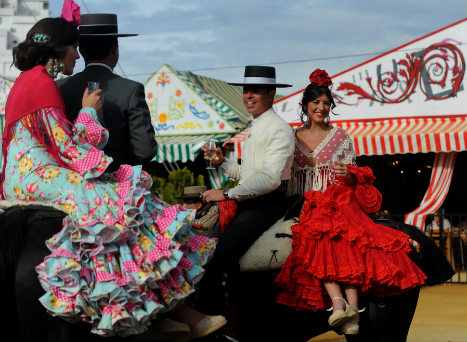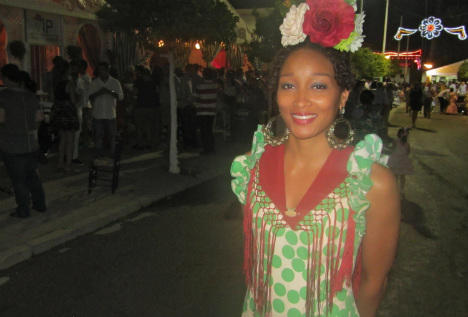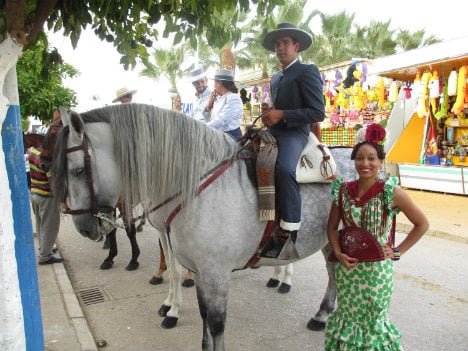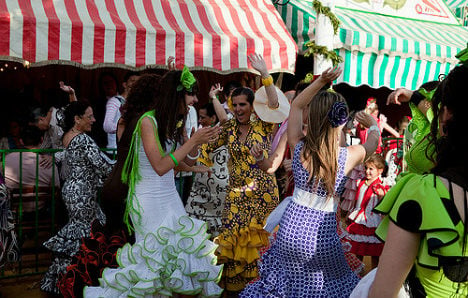[ad_1]
What’s happening this year?
Seville’s town hall is actually preparing a low-key fair which will include the decorations, pennants and lights that usually adorn the city as well as a fun fair for children.
Running from Sunday April 18th to Saturday April 24th, the local press is dubbing this year’s Feria ‘not a fair’, more to imply that it’s a celebration in disguise rather than a criticism towards the events taking place.
A precinct allowing a maximum of 9,200 people will host the main celebrations, and feria-goers will have to keep their masks on at all times unless they are eating or drinking.
There will also be a marquee at the city’s Muelle de Sal with live music where partygoers will have to remain seated to be served.
Female flamenco fashion remains an intrinsic part of the tradition, and one that helps many Seville families make ends meet, so local authorities are encouraging local women to dress to impress.
What is a feria?
Feria, as you might have guessed, means fair in English and is a week-long event celebrated at a different time of year for each city and town, primarily in the south of Spain.
Most of these fairs are typically celebrated during the spring or autumn, but there are some in the summer. If you’re familiar with the American concept of a fair: junk food, roller-coasters, games and booze, you’ll find the Spanish version not much different.
Like most things in Spain though, it is steeped in a distinct tradition all its own. So whether you’re planning to attend or have accidentally stumbled into an Andalusian city during feria (and found everything that’s not within a stone’s throw of the fairgrounds closed), here’s a quick guide that covers some of the more unique traditional aspects to get you in the spirit!

Photo: AFP
Entrance
Most towns and cities have a fair ground area where casetas or large tents are erected every year and rented to local businesses, restaurants and organizations. Ninety percent of what you’ll see when you step through the colourfully tiled archway (the signature entry point for all fairgrounds) in any feria is blocks and blocks of casetas, in front of a backdrop of roller-coasters and attractions.
READ MORE: 14 reasons why you should visit Seville this year
The casetas contain bars where food and drinks are served, a dance floor and tables. There are no entrance restrictions or fees, anyone can enter the fairgrounds, any caseta they choose and partake enjoy the food and drink. The exception to this rule, interestingly enough pertains to the city which also has the largest feria, Feria de Abril or the Seville Feria. Anyone can enter the fairgrounds, but there are few public casetas in the Seville Feria, most are privately owned, purchased by families, social groups and businesses who have restricted their casetas to respective members.
For this reason most Andalusians will tell you that “Feria de Sevilla es para los Sevillanos”, which sums it up. Feria de Abril is a spectacle to see regardless, but not as much fun unless you know someone or ideally more than one person who will grant you entrance to their caseta(s). Luckily all of the cities and large towns in Andalusia celebrate feria, and very few have private casetas, so you have many other options to experience feria if you’re not “well connected” in Sevilla.
Dress

Ayan in her traje de flamenco.
So you’ve seen the gorgeous women in the gorgeous dresses and are either thinking (depending on what kind of girl you are) do I have to do all that? Or how do I do that? No you don’t have to break the bank and buy a 200€-500€ “traje de flamenco” to attend, but I’d be lying if I didn’t say the traje is a significant part of the experience.
For me, it’s one of the only times of year I really make an effort to be fancy (other than weddings), so it’s a nice change of pace. Yep the dresses are expensive, most natives have at least two or three (that they’ve accumulated over the years) and rotate them throughout the week. If you’re a non-native like myself you might be lucky enough to have friends around your size who will loan you their dresses to wear. In my experience this has been an ideal option, but you can also hit up Humana (the Goodwill or Salvation Army of Spain) during feria season and you’re bound to find something south of 100€.
And don’t forget your complementos! The typical flowers, earrings and bracelets are a must if you’re wearing a traje, but these can be found at any of the bazaars. In many cities, women don’t begin to wear their trajes until after the second or third day of feria.

If you were one of the women who said, “do I have to do all that?” there’s good news: dressy casual attire is also completely appropriate and you’ll blend right in, as half of the women will be wearing the same. In some towns you’ll see the style of dress leaning more towards casual for those who opt not to wear a traje, but dressy casual is a safer option if you’re unsure.
Since much of the walking pathway is dirt, wear heels at your own risk, low wedges or flats are a safer choice since you’ll also be spending many hours on your feet. Last but not least, if you’re a guiri and dress in a traje be ready for plenty of attention, Spainards love to see foreigners in the traje de flamenco!
As usual, the men who will be admiring you have it much easier, the traditional traje de corto is only worn by horse riders and carriage drivers. Therefore your average guy just wears button down shirts and slacks or jeans.
Food and drink
Pescaito frito or fried fish is the most typical food at feria; menus also contain all of the other typical Spanish foods, jamón, montaditos etc and you’ll find the food prices to be slightly higher than usual, as you’d probably expect.
Amongst the casetas you’ll see cotton candy (candyfloss), churros, buñuelo, and hamburger stands if you’re just looking for a quick snack or sweets. Just make sure you’re not looking for high quality Spanish cuisine, no one goes to feria to eat. It’s a fast food atmosphere, so the food isn’t generally speaking of the highest quality.
Rebujito is the typical alcoholic beverage of feria, it is a dry white sherry called manzanilla that is mixed with Sprite. Rebujito is consumed in tiny almost shot size glasses that make it seem completely impotent alcohol wise, but underestimate it and you’re sure to wake up with a hangover you’ll never forget. Beer, as always, is commonplace as well, and if you didn’t already know, CruzCampo is the beer of the South.
Music

Woman dancing Sevillanas. Photo: mrskyce/Flickr
One of the coolest parts of feria for me is Sevillanas. Sevillanas is a traditional dance that women and men do together, that’s sweet and relatively simple. Sweet mainly because when was the last time you saw a woman and man dancing together in real life? Sevillanas reminds me of a country or traditional dance that you’d see at a cotillion maybe. Most girls begin to learn Sevillanas from the time they’re seven or so, and surprisingly enough, it’s a dance that at least half of the male Sevillanos I polled know as well which is pretty impressive.
Once you’ve heard a Sevillanas song, you’ll never forget it because they’re all the same. After two hours of hearing it and not being able to dance Sevillanas, if you’re like me you’ll probably begin to go mad from boredom, and that’s when you start looking for casetas with contemporary pop music. There are usually a few and after a certain hour are the equivalent of a club. If you’ve got the initiative though, there are Sevillanas classes in most cities and for those more coordinated amongst us, I know of a few people who’ve learned it just by watching youtube videos.
This post originally appeared on Las Morenas de España, an online community that is redefining the black experience in Spain. The brand seeks to provide information, inspiration and encouragement for people of colour living here or interested in moving to the country.
[ad_2]
Source link